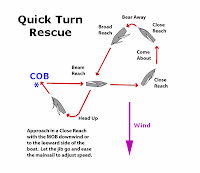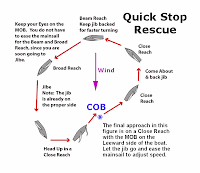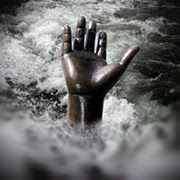Man Overboard!
There is nothing more chilling than to hear these words on a boat.
Even when doing practice drills, your heart races and mind flashes to the correct rescue procedures.
I hope a man overboard never happens. Hope is not a strategy. Training, drills, and proper equipment are a must. There are a lot of details on how to keep crew safe. Relying on technology should never be the primary mechanism. Utilizing technology in addition to rigid structure, procedures, practice and awareness can be a great addition to any boat.

 I will spend less time discussing proper man overboard (MOB) techniques, and more time discussing our safety equipment.
I will spend less time discussing proper man overboard (MOB) techniques, and more time discussing our safety equipment.
The one item we have learned is there is a strong debate between the 'figure eight' rescue technique vs. the 'quick stop' procedure. The different ASA classes we have taken have been very vocal about which technique should be used - and both instructors had different opinions. I have included a visual representation of the two primary techniques for those that are interested. You can click on each image for a larger view of the techniques.
Regardless of the techniques used, I can proudly say that Sarah in our repetitive drills on BOTH techniques did the best of anyone else on the boat. I know if I or the kids fell overboard, she would be very quick to react, and maneuver the large boat under any conditions.
There are three categories I will cover regarding equipment and technology for MOB situations: Avoiding MOB, Finding MOB, MOB at Night.
Avoiding MOB
There are a number of safety policies we will have on our boat. Keeping crew onboard is our biggest concern. There are two primary methods for keeping crew onboard: Jack-lines & Lifeline Netting.
Jack-lines are generally flat lines that run fore and aft as close to midship as possible, used for attaching safety harnesses. The primary reason you want the lines close to midship is simple. Falling overboard, but being attached to the boat and dragged in the water is not optimal. Think being a big fish dragged alongside the boat in bad weather. Not easy to recover without cutting yourself loose.
Lifeline netting is another precautionary method to keep 'things' and 'kids' from falling off. Generally lifelines by themselves will help keep most adults onboard. Kids are a different matter. Slipping and falling can and will happen. Sliding through the lifelines is a risk that we are not willing to take.
Our boat will have black netting attached to the lifelines. This is a precautionary method to assist in keeping crew and kids onboard at all times.
Finding MOB
When the worst case situation occurs, we want to be as ready as possible and spare no expense to be:
We chose the Mobialarm Crewsafe V100 system that would alert us immediately of a MOB, and provide us continuous GPS tracking of the MOB location, transmitted via VHF DSC. This signal will show up as an alert on our VHF radio, Furuno chartplotter AND our AIS plotter. This is more expensive than other units - but worth the price.
There is nothing worse than being alerted of a MOB, but NOT knowing where the person is due to foul weather, large swells, or losing sight during boat maneuvers.
MOB at Night
Yikes! The challenge of MOB...at night! Add in a mix of bad weather and you have a really bad situation. Even with the V100, and if you were within 10 - 15 meters of the MOB - it is still difficult to locate a person in the water. Leaving no stone unturned, not to mention cost, we will have onboard a technology used by the U.S. military, USCG and others search and rescue organizations -- Infrared Vision.
There are a number of options from FLIR. In the end, we chose the First Mate handheld unit for two reasons: usability in any weather & value.
With the larger units that mount on the mast, boat motion in bad weather will cause the image to be very erratic. We can quickly scan the horizon and waters around the boat with the handheld unit vs. having to use the remote control version with potentially very jumpy images. Overall, the best solution for us without having to spend over $70k for a gyro stabilized FLIR!
Conclusion
Technology should never take the place of common sense & rigorous safety measures around MOB situations. Technology is a tool, that used appropriately, will increase the odds of successful MOB recoveries. I hope we will never have to use these expensive pieces of technology...but am glad we have them 'just in case'!!
Even when doing practice drills, your heart races and mind flashes to the correct rescue procedures.
I hope a man overboard never happens. Hope is not a strategy. Training, drills, and proper equipment are a must. There are a lot of details on how to keep crew safe. Relying on technology should never be the primary mechanism. Utilizing technology in addition to rigid structure, procedures, practice and awareness can be a great addition to any boat.

 I will spend less time discussing proper man overboard (MOB) techniques, and more time discussing our safety equipment.
I will spend less time discussing proper man overboard (MOB) techniques, and more time discussing our safety equipment. The one item we have learned is there is a strong debate between the 'figure eight' rescue technique vs. the 'quick stop' procedure. The different ASA classes we have taken have been very vocal about which technique should be used - and both instructors had different opinions. I have included a visual representation of the two primary techniques for those that are interested. You can click on each image for a larger view of the techniques.
Regardless of the techniques used, I can proudly say that Sarah in our repetitive drills on BOTH techniques did the best of anyone else on the boat. I know if I or the kids fell overboard, she would be very quick to react, and maneuver the large boat under any conditions.
There are three categories I will cover regarding equipment and technology for MOB situations: Avoiding MOB, Finding MOB, MOB at Night.
Avoiding MOB
There are a number of safety policies we will have on our boat. Keeping crew onboard is our biggest concern. There are two primary methods for keeping crew onboard: Jack-lines & Lifeline Netting.
Jack-lines are generally flat lines that run fore and aft as close to midship as possible, used for attaching safety harnesses. The primary reason you want the lines close to midship is simple. Falling overboard, but being attached to the boat and dragged in the water is not optimal. Think being a big fish dragged alongside the boat in bad weather. Not easy to recover without cutting yourself loose.
Lifeline netting is another precautionary method to keep 'things' and 'kids' from falling off. Generally lifelines by themselves will help keep most adults onboard. Kids are a different matter. Slipping and falling can and will happen. Sliding through the lifelines is a risk that we are not willing to take.
Our boat will have black netting attached to the lifelines. This is a precautionary method to assist in keeping crew and kids onboard at all times.
Finding MOB
When the worst case situation occurs, we want to be as ready as possible and spare no expense to be:
- Alerted when a MOB occurs
- Directed to the location of the MOB
- MOB Alert only - sends a signal to the helm that a crew has fallen overboard. Generally an audible alarm, and in some cases will automatically flag the GPS waypoint on chart plotter (assuming it is powered on)
- MOB Alert & VHF - in addition to notifying the helm, special tracking devices on boat can be used to home in on the location of the MOB based on the VHF signal
- MOB Alert, VHF & GPS - similar to the second option, this will send out a VHF DSC alert signal with GPS coordinates of the MOB to the ships radio and AIS tracking system, updated periodically
- PLB - personal locator beacon, essentially a miniature 406 EPRIB, relaying your location and distress via satellite to ground stations, which are then rebroadcast out to ships in the area, and can take over an hour to process signal and send out alerts to ships in the area of a MOB
 |
| Crewsafe V100 |
There is nothing worse than being alerted of a MOB, but NOT knowing where the person is due to foul weather, large swells, or losing sight during boat maneuvers.
MOB at Night
 |
| Infrared Image of Person in Water |
 |
| FLIR First Mate |
With the larger units that mount on the mast, boat motion in bad weather will cause the image to be very erratic. We can quickly scan the horizon and waters around the boat with the handheld unit vs. having to use the remote control version with potentially very jumpy images. Overall, the best solution for us without having to spend over $70k for a gyro stabilized FLIR!
Conclusion
Technology should never take the place of common sense & rigorous safety measures around MOB situations. Technology is a tool, that used appropriately, will increase the odds of successful MOB recoveries. I hope we will never have to use these expensive pieces of technology...but am glad we have them 'just in case'!!







Comments
Post a Comment